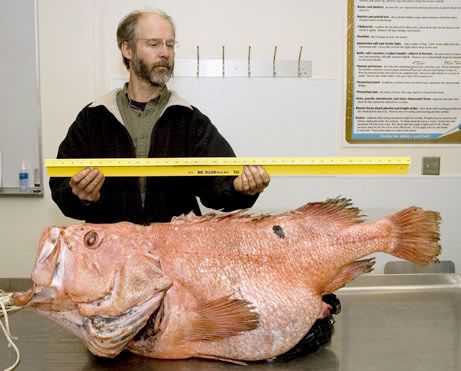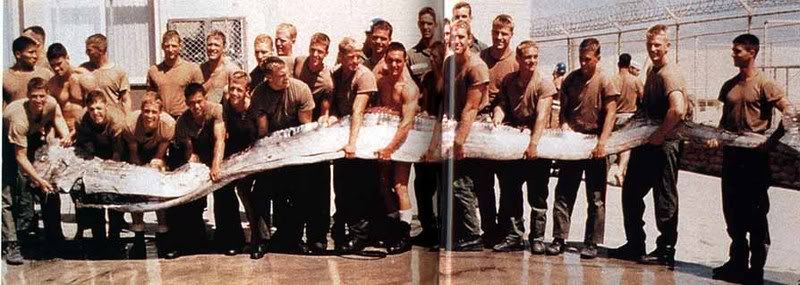JamesWhitehead
Piffle Prospector
- Joined
- Aug 2, 2001
- Messages
- 14,202
Cook it? Well it might be tasty but I suspect its real value will become clear when it's sold with a stick up its bum to clean venetian blinds. 
The Census of Marine Life is a growing global network of researchers in more than 70 nations engaged in a ten-year initiative to assess and explain the diversity, distribution, and abundance of marine life in the oceans -- past, present, and future.
source
Deep ocean trawl nets new 'bugs'
By Richard Black
Environment Correspondent, BBC News website
Catches from the deep include a possible new species of dragonfish
In pictures
A three-week voyage of discovery in the Atlantic has returned with tiny animals which appear new to science.
They include waif-like plankton with delicate translucent bodies related to jellyfish, hundreds of microscopic shrimps, and several kinds of fish.
The voyage is part of the ongoing Census of Marine Life (CoML) which aims to map ocean life throughout the world.
Plankton form the base of many marine food chains, and some populations are being disrupted by climatic change.
Zooplankton are tiny marine animals. Many live on floating plants (phytoplankton), and many are in turn eaten by fish, mammals and crustaceans.
If you say 'how do you sample the oceans and see what global climate change is doing?', you've got to have the background data
Peter Wiebe
One of the aims of the Census of Marine Zooplankton (CoMZ), part of CoML, is to provide a global inventory of these tiny organisms which will help scientists look for changes induced by climate variations or other factors.
"The deep ocean below 1,000m (3,300ft) is rarely sampled," observed Peter Wiebe, from Woods Hole Oceanographic Institution in the US, lead scientist on the recent voyage.
"It's very difficult; you need many thousands of metres of cable," he told the BBC News website. "We were able to sample at 1,000m intervals down to 5,000m (16,500 ft)."
Gooey creatures
Thousands of specimens were captured during the cruise, of which 500 have been catalogued.
They include shrimp-like copepods and ostracods, swimming worms, and tiny jellyfish - some of the gooiest and most fragile animals in the sea.
Most are adjusted to living in the cool deep, where temperatures hover around one or two Celsius.
Launching equipment from ship. Image: N Copley
Samples were caught in nets which could descend several kilometres
Bringing them to the surface meant transporting them through a layer of much warmer water, around 27C.
As soon as they came on board ship, they were plunged into ice-cooled buckets to restore a semblance of their usual habitat; even so, many perished before they could be studied.
This was one of the first projects to sequence DNA at sea, a process which Dr Wiebe believes will become much more common as scientists seek quick and easy ways to identify species.
"Many of these creatures occur in the Indian, Pacific and Atlantic oceans, and you can't tell them apart visually, but maybe we'll discover that genetically they are different," he said.
"If you say 'how do you sample the oceans and see what global climate change is doing?', you've got to have the background data."
Several more voyages are planned in the next two years specifically to examine zooplankton, and scientists involved in CoMZ are also finding places on other cruises in relevant areas.
By the time CoML ends in 2010, it hopes to have found and studied every zooplankton species in the ocean.
Photo in the News: Century-Old Fish Caught in Alaska

April 6, 2007—A handful of Christians preparing rockfish as part of their traditional fish dinner this Good Friday might be feasting on one of the oldest creatures ever to live in Alaskan waters.
Commercial fishers in the Bering Sea recently hauled in the female shortraker rockfish seen above, which scientists say was between 90 and 115 years old. Researchers at the National Oceanic and Atmospheric Administration (NOAA) used growth rings in the fish's ear bone, or otolith, to make their age estimate.
NOAA scientists also found that the fish's advanced years had yet to take a toll on its reproductive abilities.
"The belly was large," NOAA researcher Paul Spencer told the Associated Press. "The ovaries were full of developing embryos."
A Seattle, Washington-based ship caught the 44-inch-long (112-centimenter-long), 60-pound (27-kilogram) fish while trawling for pollock at about 2,100 feet (640 meters) below the surface. The massive mama was among ten shortrakers pulled from the depths along with roughly 75 tons of the smaller commercially fished species.
The fish's age and size both approach the maximum known limits for shortrakers. The largest on record measured 47 inches (119 centimeters) long, and the oldest ever caught was 157 years.
—Victoria Jaggard
http://news.nationalgeographic.com/news ... -fish.html

If it’s ”crypto”, what’s it doing on a research vessel? That’s some kind of oarfish ... a known species of oarfish. It’s a very impractical-seeming animal, though – I’ve seen footage of one swimming through the water not head first but head up, tail down!Richard_Cheese said:A Prayanar caught by a navy research vessel.
I believe this is sort of crypto. The head looks kind of like a dog or something.
bosskR said:I’ve seen footage of one swimming through the water not head first but head up, tail down!
HERE IS THE SICKENING FOOTAGEUsedtobChrisFord said:Like a seahorse? :shock:

Monsters of the deep still undiscovered
Richard Gray
June 19, 2008
GIVEN their size, you might assume they had all been found by now. But scientists believe the world's oceans are still hiding giant underwater creatures which have yet to be discovered.
Marine ecologists have predicted there could be as many as 18 unknown species, with body lengths greater than 1.8 metres, still swimming in the great expanses of unexplored sea.
Using statistical modelling, they measured the rate at which new large sea creatures have been discovered since 1830 and found that the rate of discovery is still going strong, with new species being found every year.
Most recently scientists found a new species of jellyfish that is more than 3.5 metres long off the south coast of New Zealand, along with star fish up to a metre wide.
The first full-sized carcass of a colossal squid, a deep-sea monster four metres long, was revealed for the first time earlier this year.
Dr Charles Paxton, a fisheries statistician at the University of St Andrews, Scotland, said: "There are plenty of places these creatures could be hiding.
"They may spend their lives in the middle layers of the oceans and never surface or be in the deep sea canyons yet to be visited, and new discoveries are being made all the time under the Arctic ice cap."
But for anyone hoping the results could mean that the Loch Ness Monster could still be found lurking in the depths of the famous Scottish loch, Dr Paxton has disappointing news.
He has carried out similar analysis for freshwater species and concluded that mankind has discovered all the large freshwater creatures there are to be found.
"There are small creatures being discovered all the time, but to find species that are more than two metres in length is very rare," he said. "Normally you would expect the rate of discovery of species in a habitat to level off when there are no more to be found, but with large sea creatures, the rates are still to level out, which suggests we have not found them all yet.
"Sadly for Nessie hunters, I don't think there is anything hiding in the lochs and lakes of the world any more."
He said that often legends about mythical sea creatures could be explained by real life monsters of the deep. "A lot of the mythical sea creatures such as the Kraken and sea serpents can be explained by sightings of sea creatures and mammals that are already known."
Although humans have been travelling on the oceans for thousands of years, scientists' knowledge of life beneath the waves is still extremely limited. Most species are only discovered when they are washed ashore or dredged up by fishing boats.
Deep sea exploration and underwater camera technology is now allowing scientists to explore areas that have previously been unattainable. One of the least understood parts of the ocean is actually the midlayers, known as the twilight zone, between 100 and 1000 metres down.
Dr Richard Lampitt, an ecosystems expert from the National Oceanography Centre at Southampton University, said: "It is extremely likely that there will be species of significant size still to be discovered in the deep ocean.
"The twilight zone, where natural sunlight is extinguished, has not really been sampled properly so there will be large creatures to be found there too."
A spokesman for the Marine Conservation Society added: "The mid-layers of the oceans are so unexplored and the sea floor is so massive that there are almost certainly some giants there that are still to be found.
"It makes a very strong case for protecting the oceans, particularly the high seas where not every country has signed up to international treaties."
Telegraph, London
Fishy tales
KRAKEN
From Norwegian folklore, a creature with tentacles that could embrace a ship and crush the hull. Scientists believe sightings could have been giant and colossal squids.
OAR FISH
The longest bony fish known to science can grow to more than 10.9 metres long. Giant sea serpent sightings could have been oar fish.
MEGAMOUTH SHARK
A deep sea shark first discovered in 1976. It can measure up to 5.4 metres and weigh more than 1.2 tonnes.
COLOSSAL SQUID
The largest known squid species, thought to be capable of growing up to 14 metres long. It is believed to have the biggest eye in the animal kingdom and lives at depths of about 2000 metres.
eburacum said:


Ghost-Shark Caught on Film for the First Time*.
"Most remarkably perhaps, they have a retractable penis on their heads."

